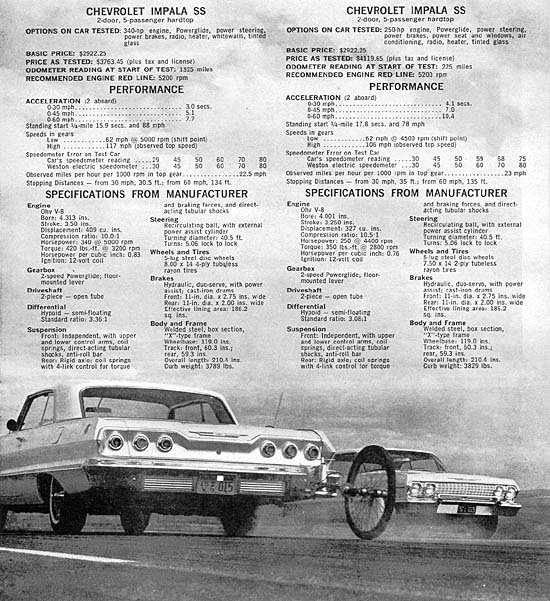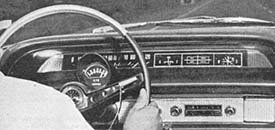 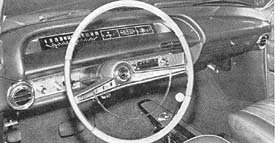 |
| 6000-rpm tachometer is a useful extra-cost option. Shroud on tach and hood over instrument panel keep glare off windshield at night. Driving position would be better with lower wheel. |
| Getting the right traction was a problem with the "409." The car should have been equipped with the Positraction rear axle but wasn't, and as a result, too much initial throttle would cause the right rear tire to burn excessively.
At the drags (under '63 NHRA rules), the "409" would have to run in A/SA, which will be a real rough class this year (it was Super/Stock last year). For this kind of action, either the 4.11 or 4.56 optional rear axles would have to be installed (preferably Positraction), and the car would also need "cheater" slicks in place of the stock tires. Only time and actual results will tell, but we can't help but think that the two-speed automatic will be at a distinct disadvantage against some of the three-speed automatics used by other manufacturers. |
  |
| 6000-rpm tachometer is a useful extra-cost option. Shroud on tach and hood over instrument panel keep glare off windshield at night. Driving position would be better with lower wheel. |
| Down the long Riverside Raceway backstretch, the "409"
reached 117 mph and still felt as if it would go a bit faster. At 106 mph, the "327" was all out of breath. The "409" was also a much more stable car at speed, due to the stiffer springs that are part of the "409" option. The "327" had the characteristic floating feel that one associates with soft, coil-spring suspension, while the "409" felt like a completely different car. Quite a bit of annoying side sway was also evident in the "327."
Tight, quick cornering also showed up a world of difference between the "327" and the "409." Both cars use the same diameter anti-roll bar, but the stiffer springs keep the "409" more level and sure-footed (it feels as light as any compact), while the "327" leaned heavily and plowed the front wheels badly. One other difference in equipment that affected the handling characteristics of the two test cars was the four-ply tires, standard on the "409," and the two-plies that come with the "327." |
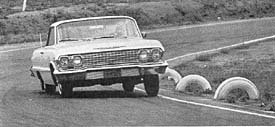 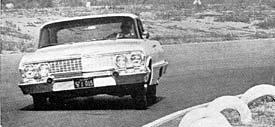 |
| The big engine option includes stifter springs. The "409" (LEFT) corners much flatter and with considerably less evident understeer than "327" Impala (RIGHT). |
| Driving these two cars within minutes of each other under
identical conditions was a real eye-opener as to just what extreme (almost ridiculous) lengths a manufacturer (Chevrolet isn't alone in this) will go in pursuit of a so-called comfortable boulevard ride. As near as we could tell, the "409" was every bit as comfortable, without a trace of harshness in the ride, as the "327." In fact, we got a distinctly uncomfortable feeling with the softly sprung "327" mushing about beneath us. In our opinion, this is a good example of where a degree of actual safety has been sacrificed in favor of an imagined degree of comfort.
Self-adjusting brakes are now used on all Chevrolets, and like those of other manufacturers, adjust automatically on reverse stops. Both cars stopped in equally short distances from 60 mph. Fade was encountered when the brakes were used excessively, but they bounced right back after a short cool-down period. On panic stops the "327" had a tendency to "wag its tail," which meant that constant steering wheel corrections were needed to keep it in a straight line. Stiffer suspension made the "409" a much better behaved car during panic stops. The power brakes required light pedal applications to keep from locking up the wheels. The standard brakes are light enough, and the average driver (male or female) shouldn't have any trouble getting along without power assist. |
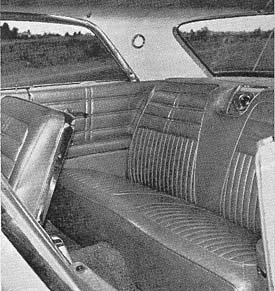 Door opening is wide enough for easy entry or exit, and the interior is big enough to handle a full load of good-sized adults on long-distance jaunts. |
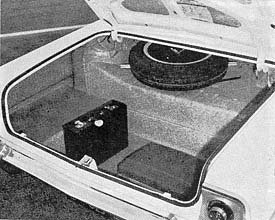 Trunk sill is low enough to avoid interfering with loading procedures, and with spare out of way, usable area is plentiful. |
| Neither the "327" nor the "409" will ever win any economy contests. The "409" was well broken in and in good tune, so our figures are about as good (or bad) as the average owner can expect. Around town, we got an average of 10.2 mpg. Mixed city and freeway travel brought this up to 12.4 mpg. The tests at Riverside dropped the figure way down to 6.8 mpg. The "327" wasn't completely broken in, and every tank of gas showed improvement. Figures on this one ranged from 7.7 mpg at Riverside to 14.2 on the highway. Properly broken in, the overall average would be in the 12-to-16-mpg range.
The basic Chevrolet body configuration is very much like last year's, with the main difference in appearance coming from the use of all-new body panels below the belt line and restyled front and rear sheet metal. All body styles now have the straight windshield pillar, and the wrap-around windshield has become a thing of the past. Chevrolet's quality control always impresses us. It's the equal of a lot of cars costing quite a bit more. All panels, doors and trim were perfectly aligned and fit flush on both test cars. Even after a lot of hard usage, neither car developed any squeaks or rattles, and several trips through a car wash showed them to be weather-tight. Interiors are tastefully done in top-grade loop pile carpeting and tough-wearing, rich-looking expanded vinyl. The bucket-type seats are fairly comfortable, but would be even more so if the seat back were designed with a concave instead of a convex contour. The interior is roomy enough to carry five good-sized adults'on long trips comfortably, with enough usable luggage space to accommodate their needs. The driver's seat offered enough adjustment for our near six-foot frame. We weren't completely happy with the steering wheel location. It's far from the dash and close to the driver and either too big in diameter or mounted too high. The top of the rim was almost level with our eyes. Even though only the fuel gauge is "real," the dash is still quite impressive - if only in its simplicity. In addition to the usual oil, temp, and amp red warning lights, there's a green one that comes on when the engine's cold. Other new features for 1963 include an alternator (Delcotron) on all models, extended-life exhaust systems, as well as extended oil-change and lubrication intervals, and a 24,000-mile or 24-month warranty. |
